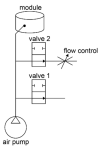Development of a Soft Robotics Module for Active Control of Sitting Comfort
- PMID: 35334768
- PMCID: PMC8954731
- DOI: 10.3390/mi13030477
Development of a Soft Robotics Module for Active Control of Sitting Comfort
Abstract
Sitting comfort is an important factor for passengers in selecting cars, airlines, etc. This paper proposes a soft robotic module that can be integrated into the seat cushion to provide better comfort experiences to passengers. Building on rapid manufacturing technologies and a data-driven approach, the module can be controlled to sense the applied force and the displacement of the top surface and actuate according to four designed modes. A total of 2 modules were prototyped and integrated into a seat cushion, and 16 subjects were invited to test the module's effectiveness. Experiments proved the principle by showing significant differences regarding (dis)comfort. It was concluded that the proposed soft robotics module could provide passengers with better comfort experiences by adjusting the pressure distribution of the seat as well as introducing a variation of postures relevant for prolonged sitting.
Keywords: adaptive; comfort; pneumatics; seat; soft-robotics module.
Conflict of interest statement
The authors declare no conflict of interest.
Figures














References
-
- Kilincsoy U. Digitalization of Posture-Based Seat Design: Developing Car Interiors by Involving User Demands and Activities. Delft University of Technology; Delft, The Netherlands: 2019. - DOI
-
- Yao X., He Y., Hessenberger N., Buso A., Song Y., Vink P. Posture detection using pressure distribution in an aircraft seat: Bottom is better than top. Appl. Ergon. 2022
-
- SENSIMAT SENSIMAT for Wheelchairs. 2021. [(accessed on 1 March 2022)]. Available online: https://www.sensimatsystems.com/
-
- van Veen S., Orlinskiy V., Franz M., Vink P. Investigating Car Passenger Well-Being Related to a Seat Imposing Continuous Posture Variation. J. Ergon. 2015;5:3. doi: 10.4172/2165-7556.1000140. - DOI
LinkOut - more resources
Full Text Sources

